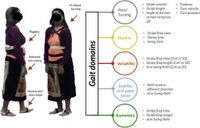A recent narrative review reveals the evolving landscape of digital biomarkers in the assessment and monitoring of Parkinson's disease (PD), emphasizing gait analysis as a crucial component in this endeavor. The study brings to light the significance of understanding various gait parameters across four vital contexts: disease susceptibility or risk, disease progression, response to exercise, and prediction of falls. With a projected global prevalence of Parkinson's disease reaching 25.2 million cases by 2050, researchers are now placing greater emphasis on innovative approaches to track and manage this debilitating condition.
The review indicates that gait characteristics, such as pace and stability, are particularly informative when tracking the disease's progression and response to therapeutic interventions. For instance, metrics like gait speed and stride length have been crucial in evaluating how individuals with PD respond to exercise, supported by findings from various studies. Dynamic stability aspects, including trunk regularity and double-support time, are expected to worsen with disease progression but show potential improvement with dedicated exercise regimens. Gait variability also emerges as a responsive marker across all contexts, although its specificity might be limited, offering both challenges and opportunities for clinicians.
As the time from diagnosis increases, the review highlights a concerning fact: by the stage of clinical diagnosis, a significant percentage of nigral dopaminergic neurons—between 50% to 70%—are already lost. This underscores the need for early identification of signs and symptoms, which can potentially be indicated through digital gait analysis. Technologies associated with gait analysis, such as inertial measurement units (IMUs) and other wearable sensors, provide a means to monitor vital aspects of movement either in a clinical setting or in everyday life.
In an associated editorial, experts argue for the adoption of rigorous modeling techniques to better guide resource allocation and inform research strategies. They warn that current methods of prevalence extrapolation may underestimate the future incidence of PD. “As Parkinson’s disease cases are expected to rise sharply, adopting rigorous modelling techniques is essential to guide resource allocation, inform policy decisions, and advance research efforts,” noted Tobias Kurth of the Institute of Public Health, Charité — Universitätsmedizin Berlin, and his colleagues.
As the landscape of PD research changes, the narrative review sheds light on how digital gait biomarkers can significantly impact clinical outcomes. However, a serious limitation lies in the lack of standardized testing protocols. The review calls for establishing a foundational set of quantified gait biomarkers to harmonize data collected across diverse studies. Consistency in methodology will be crucial for achieving reliable comparisons of gait metrics in future clinical trials.
Drawing on evidence detailed in the review, it's clear that gait digital biomarkers can serve multiple purposes: from flagging early signs of disease susceptibility among healthy individuals with specific genetic mutations to tracking the progression of impairments among those diagnosed. The presence of idiopathic REM sleep behavior disorder (iRBD) is highlighted as a particularly strong risk factor for developing neurodegenerative disorders, including PD, during the median prodromal phase of 8 years. Interestingly, the prevalence of iRBD in patients with PD is reported to be around 42%, suggesting a crucial window for intervention.
For clinicians, the implications are significant. The ability to leverage gait characteristics to predict fall risk—early identification of patients in danger of losing independence—could transform the management of PD. The urgency of this need is underscored by the potential for falls to affect quality of life dramatically. In response to these challenges, ongoing research and developments in wearable technologies are steadily advancing the capabilities of gait analysis.
As the digital transformation of health continues, studies are already underway exploring various methodologies to ensure more accurate assessments of gait in patients with PD. It’s critical to recognize the expansion of insights into functional mobility and how these can be utilized to inform treatment strategies aimed at improving patient outcomes. With the interwoven nature of gait characteristics and the evolution of PD over time, researchers advocate for increased attention to refining measurement techniques, allowing for better tracking of disease progression and therapeutic response.
In summary, advancements in understanding gait as a digital biomarker for PD are not only necessary but timely. As the disease's prevalence is expected to surge dramatically, the integration of innovative digital health technologies promises to enhance diagnosis, monitor treatment efficiency, and shape the future of personalizing care for those affected by this life-altering condition. The goal remains clear: improving the quality of life for millions living with Parkinson’s disease in the face of increasing global prevalence.


